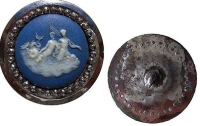








In modern clothing and fashion design, a button is a small fastener, most commonly made of plastic, but also frequently of seashell, which secures two pieces of fabric together. In archaeology, a button can be a significant artifact. In the applied arts and in craft, a button can be an example of folk art, studio craft, or even a miniature work of art.
Buttons are most often attached to articles of clothing but can also be used on containers such as wallets and bags. However, buttons may be sewn onto garments and similar items exclusively for purposes of ornamentation. Buttons serving as fasteners work by slipping through a fabric or thread loop, or by sliding through a buttonhole. Other types of fastenings include zippers, Velcro and magnets.
Some museums and art galleries hold culturally, historically, politically, and/or artistically significant buttons in their collections. The Victoria & Albert Museum has many buttons, particularly in its jewellery collection, as does the Smithsonian Institution.
Hammond Turner & Sons, a button-making company in Birmingham, hosts an online museum with an image gallery and historical button-related articles, including an 1852 article on button-making by Charles Dickens. In the USA, large button collections are on public display at The Waterbury Button Museum of Waterbury, Connecticut, the Keep Homestead Museum of Monson, Massachusetts, which also hosts an extensive online button archive and in Gurnee, Illinois at The Button Room.
Buttons and button-like objects used as ornaments or seals rather than fasteners have been discovered in the Indus Valley Civilization during its Kot Yaman phase (circa 2800–2600 BCE) as well as Bronze Age sites in China (circa 2000–1500 BCE), and Ancient Rome.
Buttons made from seashell were used in the Indus Valley Civilization for ornamental purposes by 2000 BCE.Some buttons were carved into geometric shapes and had holes pierced into them so that they could be attached to clothing with thread.Ian McNeil (1990) holds that: ""The button, in fact, was originally used more as an ornament than as a fastening, the earliest known being found at Mohenjo-daro in the Indus Valley. It is made of a curved shell and about 5000 years old.""
The earliest functional buttons were found in the tombs of conquering Hungarian tribes from the late 9th century.Functional buttons with buttonholes for fastening or closing clothes appeared first in Germany in the 13th century.They soon became widespread with the rise of snug-fitting garments in 13th- and 14th-century Europe.